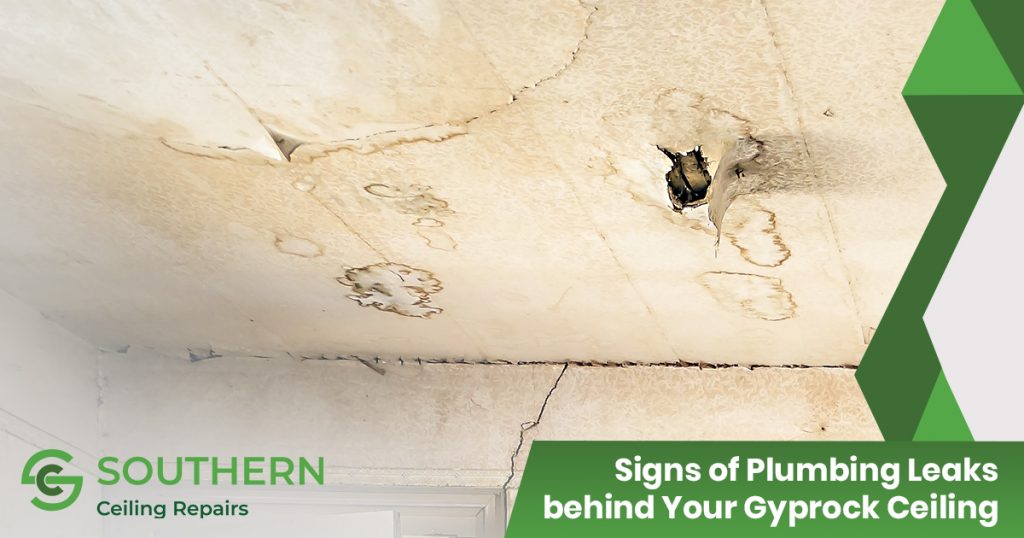
Spotting water damage in your walls early is vital for keeping your home safe and sound. In Australia, different signs of water damage in walls can indicate moisture issues that, if left unchecked, may lead to expensive structural repairs.
Here are some common signs of water damage in walls and practical advice on what you can do to fix them:
1. Stains and Discolouration
If you notice odd brown or yellow stains on your walls or ceilings, it’s often a sign of a water damaged ceiling, meaning water is getting into places it shouldn’t. These marks could be from a leaking roof, a plumbing issue, or moisture creeping in from outside.
2. Bubbling or Peeling Paint
When paint or wallpaper starts bubbling, cracking, or peeling, it’s a sign that there’s moisture building up underneath the surface and could require sagging ceiling or wall repair with Southern Ceiling Repairs. Water damage like this needs attention, as ignoring it can lead to more extensive and costly repairs down the track.
3. Mould Growth
Black mould spots or a musty smell can be strong signs of prolonged moisture exposure. Mould thrives in damp areas and can affect the air quality in your home, posing health risks to you and your family.
It’s important to address this issue as soon as possible to prevent it from spreading—contact us for a free consultation to get the right solution.
4. Warping or Softening of Walls
When you press against your drywall and feel soft spots or notice areas bulging, it’s likely due to water infiltration. Warped walls can weaken your home’s structure and often need immediate assessment by a professional to determine the extent of the damage.

5. Dark or Wet Spots
Keep an eye out for dark patches or wet spots on your walls. These can be signs of leaks, either from plumbing or from water seeping in from outside.
Sometimes, condensation buildup can also cause these patches. It’s crucial to fix the source of the issue before it gets worse.
6. Increased Utility Bills
A sudden spike in your water bill without any change in how much water you use may indicate a hidden leak behind your walls. Monitoring your utility bills can be a helpful way to detect water damage early.
7. Sounds of Running Water
If you hear unusual noises like dripping or running water when all your taps are off, it might suggest a hidden leak within the walls. Investigating these sounds promptly can help prevent the damage from spreading.
8. Pooling Water
Puddles forming near walls or in corners of your home are clear signs of a leak. It’s crucial to act fast if you see water pooling, as this can quickly lead to mould growth and damage to your home’s structure.
How to Fix a Leaking Pipe Behind a Wall
If you spot any of these signs, it’s essential to act quickly to avoid bigger issues down the line. Here’s what you can do:
Call in the Professionals
Contact water damage restoration experts. They can assess the situation and suggest the best course of action to fix it.
Professionals can also help identify the source of the leak, ensuring that it is fully repaired.
Dry Out the Area
Use fans and dehumidifiers to dry out any wet areas thoroughly. It’s important to do this quickly to stop mould from growing.
If the water damage is extensive, professionals may use specialised equipment to remove moisture.
Inspect Plumbing and Roofs
Check your plumbing and roof for any signs of damage that could be causing the leaks. It’s a good idea to get a plumber or roofing expert involved to repair any issues before they worsen.
Keep an Eye on the Area
After the repairs, monitor the affected area to ensure the problem doesn’t return. Look out for any recurring wet spots, discolouration, or unusual smells.
Prevention is Key
Preventing water damage before it occurs can save you time, money, and stress. Regularly inspecting your roof, gutters, and plumbing systems can help you catch any potential problems early.
Ensuring proper drainage around your home and sealing any cracks in walls or foundations can also reduce the risk of water infiltration. By acting quickly and staying alert to these signs, you can keep your home safe and prevent costly repairs.
If you need help or suspect water damage, don’t hesitate to contact local experts for advice or assistance. Stay proactive, and protect your home from water damage today!
